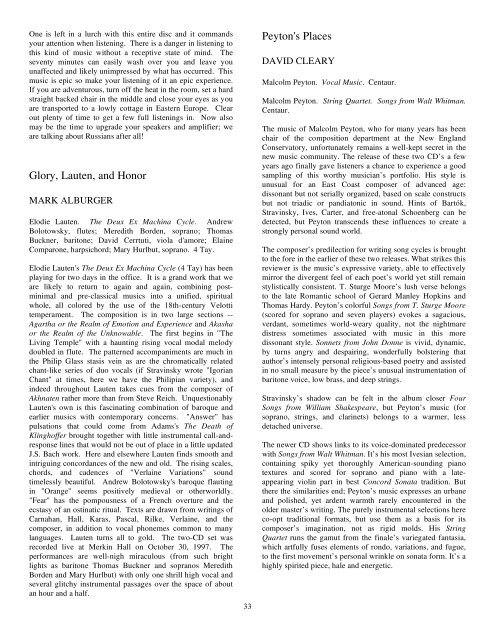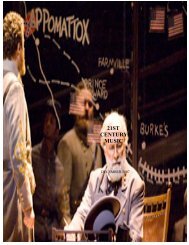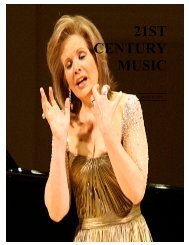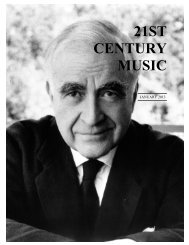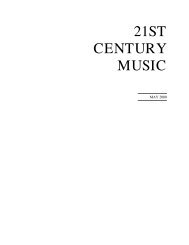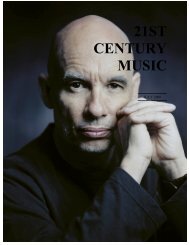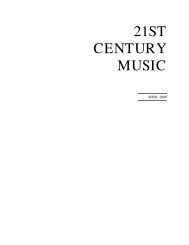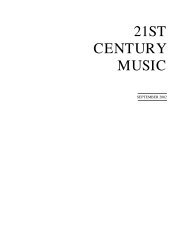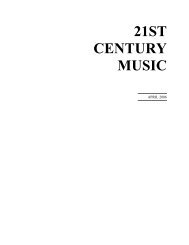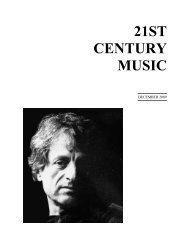You also want an ePaper? Increase the reach of your titles
YUMPU automatically turns print PDFs into web optimized ePapers that Google loves.
One is left in a lurch with this entire disc and it commands<br />
your attention when listening. There is a danger in listening to<br />
this kind of music without a receptive state of mind. The<br />
seventy minutes can easily wash over you and leave you<br />
unaffected and likely unimpressed by what has occurred. This<br />
music is epic so make your listening of it an epic experience.<br />
If you are adventurous, turn off the heat in the room, set a hard<br />
straight backed chair in the middle and close your eyes as you<br />
are transported to a lowly cottage in Eastern Europe. Clear<br />
out plenty of time to get a few full listenings in. Now also<br />
may be the time to upgrade your speakers and amplifier; we<br />
are talking about Russians after all!<br />
Glory, Lauten, and Honor<br />
MARK ALBURGER<br />
Elodie Lauten. The Deux Ex Machina Cycle. Andrew<br />
Bolotowsky, flutes; Meredith Borden, soprano; Thomas<br />
Buckner, baritone; David Cerrtuti, viola d'amore; Elaine<br />
Comparone, harpsichord; Mary Hurlbut, soprano. 4 Tay.<br />
Elodie Lauten's The Deux Ex Machina Cycle (4 Tay) has been<br />
playing for two days in the office. It is a grand work that we<br />
are likely to return to again and again, combining postminimal<br />
and pre-classical musics into a unified, spiritual<br />
whole, all colored by the use of the 18th-century Velotti<br />
temperament. The composition is in two large sections --<br />
Agartha or the Realm of Emotion and Experience and Akasha<br />
or the Realm of the Unknowable. The first begins in "The<br />
Living Temple" with a haunting rising vocal modal melody<br />
doubled in flute. The patterned accompaniments are much in<br />
the Philip Glass stasis vein as are the chromatically related<br />
chant-like series of duo vocals (if Stravinsky wrote "Igorian<br />
Chant" at times, here we have the Philipian variety), and<br />
indeed throughout Lauten takes cues from the composer of<br />
Akhnaten rather more than from Steve Reich. Unquestionably<br />
Lauten's own is this fascinating combination of baroque and<br />
earlier musics with contemporary concerns. "Answer" has<br />
pulsations that could come from Adams's The Death of<br />
Klinghoffer brought together with little instrumental call-andresponse<br />
lines that would not be out of place in a little updated<br />
J.S. Bach work. Here and elsewhere Lauten finds smooth and<br />
intriguing concordances of the new and old. The rising scales,<br />
chords, and cadences of "Verlaine Variations" sound<br />
timelessly beautiful. Andrew Bolotowsky's baroque flauting<br />
in "Orange" seems positively medieval or otherworldly.<br />
"Fear" has the pompousness of a French overture and the<br />
ecstasy of an ostinatic ritual. Texts are drawn from writings of<br />
Carnahan, Hall, Karas, Pascal, Rilke, Verlaine, and the<br />
composer, in addition to vocal phonemes common to many<br />
languages. Lauten turns all to gold. The two-CD set was<br />
recorded live at Merkin Hall on October 30, 1997. The<br />
performances are well-nigh miraculous (from such bright<br />
lights as baritone Thomas Buckner and sopranos Meredith<br />
Borden and Mary Hurlbut) with only one shrill high vocal and<br />
several glitchy instrumental passages over the space of about<br />
an hour and a half.<br />
33<br />
Peyton's Places<br />
DAVID CLEARY<br />
Malcolm Peyton. Vocal <strong>Music</strong>. Centaur.<br />
Malcolm Peyton. String Quartet. Songs from Walt Whitman.<br />
Centaur.<br />
The music of Malcolm Peyton, who for many years has been<br />
chair of the composition department at the New England<br />
Conservatory, unfortunately remains a well-kept secret in the<br />
new music community. The release of these two CD’s a few<br />
years ago finally gave listeners a chance to experience a good<br />
sampling of this worthy musician’s portfolio. His style is<br />
unusual for an East Coast composer of advanced age:<br />
dissonant but not serially organized, based on scale constructs<br />
but not triadic or pandiatonic in sound. Hints of Bartók,<br />
Stravinsky, Ives, Carter, and free-atonal Schoenberg can be<br />
detected, but Peyton transcends these influences to create a<br />
strongly personal sound world.<br />
The composer’s predilection for writing song cycles is brought<br />
to the fore in the earlier of these two releases. What strikes this<br />
reviewer is the music’s expressive variety, able to effectively<br />
mirror the divergent feel of each poet’s world yet still remain<br />
stylistically consistent. T. Sturge Moore’s lush verse belongs<br />
to the late Romantic school of Gerard Manley Hopkins and<br />
Thomas Hardy. Peyton’s colorful Songs from T. Sturge Moore<br />
(scored for soprano and seven players) evokes a sagacious,<br />
verdant, sometimes world-weary quality, not the nightmare<br />
distress sometimes associated with music in this more<br />
dissonant style. Sonnets from John Donne is vivid, dynamic,<br />
by turns angry and despairing, wonderfully bolstering that<br />
author’s intensely personal religious-based poetry and assisted<br />
in no small measure by the piece’s unusual instrumentation of<br />
baritone voice, low brass, and deep strings.<br />
Stravinsky’s shadow can be felt in the album closer Four<br />
Songs from William Shakespeare, but Peyton’s music (for<br />
soprano, strings, and clarinets) belongs to a warmer, less<br />
detached universe.<br />
The newer CD shows links to its voice-dominated predecessor<br />
with Songs from Walt Whitman. It’s his most Ivesian selection,<br />
containing spiky yet thoroughly American-sounding piano<br />
textures and scored for soprano and piano with a lateappearing<br />
violin part in best Concord Sonata tradition. But<br />
there the similarities end; Peyton’s music expresses an urbane<br />
and polished, yet ardent warmth rarely encountered in the<br />
older master’s writing. The purely instrumental selections here<br />
co-opt traditional formats, but use them as a basis for its<br />
composer’s imagination, not as rigid molds. His String<br />
Quartet runs the gamut from the finale’s variegated fantasia,<br />
which artfully fuses elements of rondo, variations, and fugue,<br />
to the first movement’s personal wrinkle on sonata form. It’s a<br />
highly spirited piece, hale and energetic.


